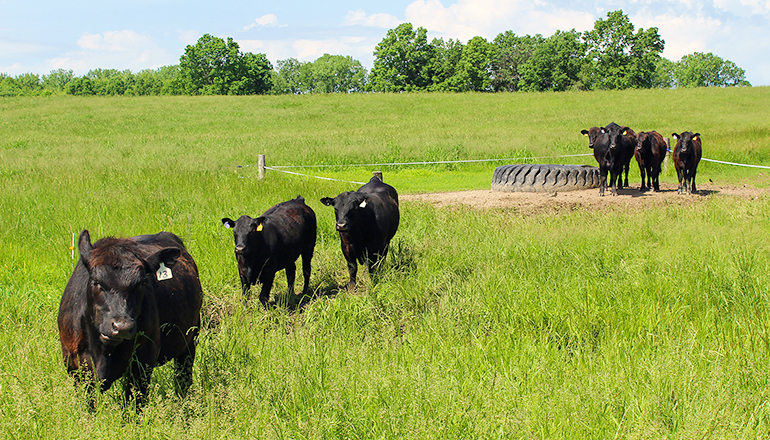Twenty-five years ago, Brian Pemberton bought acreage filled with thorn trees, scrub brush and multiflora roses. The only water source was a frog pond. The land needed four things: a road, buildings, fences, and water.
Thanks to hard work and cost-share programs, those goals were met. Grazing Acres Farm is now complete with a solid road, a central barn and 35 fenced rotational grazing paddocks with a water supply in each.
The 232-acre system was recently showcased during a pasture walk sponsored by the University of Missouri Extension and the USDA Natural Resources Conservation Service as part of a two-day grazing school in Monroe County. MU Extension livestock specialist Daniel Mallory says the Pemberton operation shows how a rotational grazing system provides reliable sources of forage, water, and shade for cattle.
Three generations of Pembertons, including Brian, father Richard, and son Cade, run the grassland farm in the northwest corner of Monroe County. Up to four black Angus herds rotate on the paddocks, depending upon the time of the year and weather conditions. They move in sequence from one paddock to the next every one to three days for the best use of forage and improved animal performance.
The Pembertons renovated toxic fescue pastures, both chemically and through tillage. Now they grow a mix of warm- and cool-season grasses, including big bluestem, eastern gamagrass, rye, orchard grass, reed canary grass, red clover, and bird’s-foot trefoil.
Despite the Pembertons’ best efforts, fescue keeps creeping back into pastures. “It’s a never-ending battle,” Richard says. Even with rotational grazing, cattle eat what they like first. This opens up small areas for the fescue to take hold.
They strive to graze stockpiled grasses until Thanksgiving in order to feed less stored hay in winter. Grass was so plentiful in 2018 that cattle grazed until Christmas, Brian says.
The mixture of grasses lets producers take advantage of different growth patterns to allow time for regrowth to extend grazing, says Mallory.
The Pembertons see several benefits of rotational grazings, such as pasture rest, time for regrowth and soil conservation. They perform biannual soil testing and add lime to their pastures as needed.
To supplement the summer slump, the Pembertons add annuals. Last fall, they planted 80 acres of annual rye to harvest as baleage this spring. “The best way to reduce effects of toxic fescue is dilution,” Mallory says. “A great way to add another forage during summer is summer annuals.” Cool, wet weather makes it difficult to dry hay, so the Pembertons put up 80% of their forage into baleage.
Another benefit of rotational grazing is that cattle become gentler with regular human contact during moves to fresh paddocks. A gentle herd first begins in the “wintering lot” where cattle are “bucket broke.” The Pembertons buy 450- to 600-pound black Angus heifers from private treaties. Each heifer is fed 2 pounds of feed daily from long troughs on either side of a concrete walkway. The daily contact makes them more comfortable with owners approaching them and rotating them to new pastures.
The heifers breed naturally with low-birth-weight Angus bulls bought from a local supplier. A local veterinarian performs pregnancy checks in spring and fall. Yearling heifers undergo reproductive tract scoring before breeding. The Pembertons run a fall- and spring-calving herd.
Today, four dams that include gravity flow and pressure systems supply the 14 tire tanks that provide water to every paddock. Used scraper tires make excellent waterers because the large oval openings allow multiple animals to drink at one time. The tires are economical and practically indestructible, says Brian. Tanks are placed so that cattle are within 600 feet of water at all times. Shade trees offer protection in every paddock.
The Pembertons credit cost-sharing through NRCS’s Environmental Quality Incentive Program, the Monroe County Soil and Water Conservation District, and the 2002 Farm Bill’s Conservation Security Program for helping them achieve their goals. The three programs helped fund fencing, watering systems, and structures on the farm.
The Farmers Home Administration’s Beginning Farmer Program had provided Brian with the initial funding for land.
Brian says their systems may not be for everyone, but it works well for them. They continually tweak their systems, adapting them to the needs of a three-generation team.
Learn more about grasslands management from the NRCS + MU Grasslands Project at THIS LINK.
Why the right watering system matters
Mark Kennedy, the owner of Kennedy Grassland Services of Reeds Spring, Mo., says the right livestock watering system improves herd health and efficiency. Kennedy, who is also a retired NRCS state grazing lands specialist, outlines the reasons in a slide presentation, “Livestock Watering Systems,” available as a downloadable PDF at THIS LINK.
Cattle come to water two to five times daily. They drink one to four minutes each time at a rate of 2 gallons per minute. In hot weather, they can drink up to 25 gallons of water or an average of 3-5 pounds of water per pound of body weight. Calves need better-quality water than cows. They often avoid going through mud and other obstacles to reach a water source. They drink 5-7 pounds of water per pound of body weight.
Cattle that have water within 600-800 feet drink 15% more water than cattle that have to walk more than 1,000 feet. That is why having water in each paddock and close to cattle matters so much, Kennedy says.
Cattle “drink socially” when traveling farther. Kennedy recommends tank space for 10% of the herd with a flow rate sufficient to water the herd in 20 minutes. On the other hand, cattle tend to drink “individually” when the paddock is smaller than 10 acres or the cattle have to travel 1/8 mile or less for water. In this situation, the herd owner can usually get by with a smaller tank and less flow.






